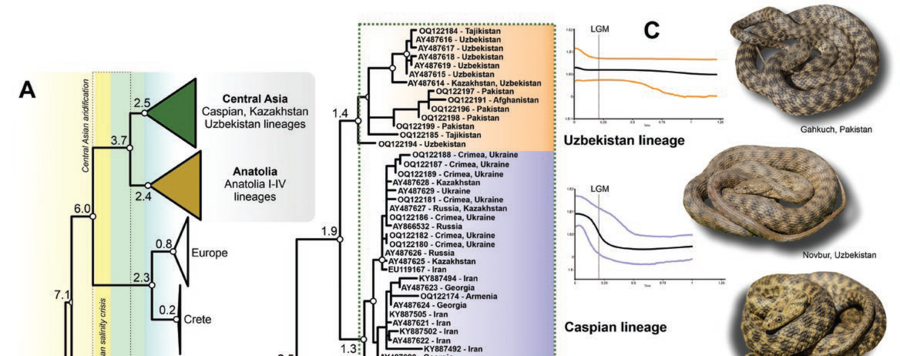
The Silk roads: phylogeography of Central Asian dice snakes (Serpentes: Natricidae) shaped by rivers in deserts and mountain valleys
Influenced by rapid changes in climate and landscape features since the Miocene, widely distributed species provide suitable models to study the environmental impact on their evolution and current genetic diversity. The dice snake Natrix tessellata, widely distributed in the Western Palearctic is one such species. We aimed to resolve a detailed phylogeography of N. tessellata with a focus on the Central Asian clade with 4 and the Anatolia clade with 3 mitochondrial lineages, trace their origin, and correlate the environmental changes that affected their distribution through time. The expected time of divergence of both clades began at 3.7 Mya in the Pliocene, reaching lineage differentiation approximately 1 million years later. The genetic diversity in both clades is rich, suggesting different ancestral areas, glacial refugia, demographic changes, and colonization routes. The Caspian lineage is the most widespread lineage in Central Asia, distributed around the Caspian Sea and reaching the foothills of the Hindu Kush Mountains in Afghanistan, and Eastern European lowlands in the west. Its distribution is limited by deserts, mountains, and cold steppe environments. Similarly, Kazakhstan and Uzbekistan lineages followed the Amu Darya and the Syr Darya water systems in Central Asia, with ranges delimited by the large Kyzylkum and Karakum deserts. On the western side, there are several lineages within the Anatolia clade that converged in the central part of the peninsula with 2 being endemic to Western Asia. The distribution of both main clades was affected by expansion from their Pleistocene glacial refugia around the Caspian Sea and in the valleys of Central Asia as well as by environmental changes, mostly through aridification.






